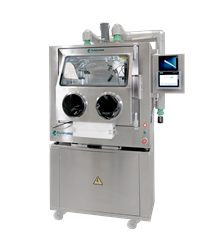Ultra-clean biomedical nanofiber production now available from Nanoscience Instruments
Aseptic bioprocesses and sterile medical devices can now utilize electrospinning with the introduction of the new Fluidnatek electrospinning systems

Fluidnatek LE-50 ProSterile Electrospinning System
“The Fluidnatek systems for biomedical applications have elevated the electrospinning technique into a new era of ultra-clean medical device processing. They are meticulously designed to maintain an exceptional standard of sterility.” - Francisco J. Chaparro, PhD, Application Scientist
PHOENIX (PRWEB) December 16, 2021
Nanoscience Instruments introduces the new biomedical Fluidnatek electrospinning systems into the US Market. Designed and built by Fluidnatek in Valencia, Spain, the new systems overcome the lack of features from commercial electrospinning equipment. The new additions deliver reproducible and scalable results, and maintain the level of sterility required for electrospinning processes in biomedical applications that fall under ISO-5, cGMP, and ISO-13485 standards.
The Fluidnatek LE-50 ProSterile and LE-100 Bio are the only electrospinning and electrospraying systems on the market that are designed specifically for a sterile process from start to finish. With these systems, you can meet FDA, cGMP, and/or ISO-13485 standards with ease, as well as carefully control processing parameters for perfect nanofibers, every time.
Nanoscience Instruments Application scientist Francisco J. Chaparro, PhD, has worked extensively with electrospinning systems, from home-built units, to premium, industrial grade systems. Dr. Chaparro explains, “The new Fluidnatek systems for biomedical applications have elevated the electrospinning technique into a new era of ultra-clean medical device processing. Meticulously designed with a comprehensive list of new features such as HEPA filtration, stainless steel interior and exterior, and a chamber sterilization system, the LE-50 ProSterile and LE-100 Bio maintain an exceptional standard of sterility and cleanliness.”
With welded stainless steel interiors and exteriors with no crevices or gaps, and a vacuum chamber, these systems can maintain ISO-5 (Class 100) conditions at all times. In addition, the vacuum chamber is designed to remove traces of solvents, which eliminates the need for post process sterilization, and enables packaging of final products under sterile conditions inside the chamber. “Each new feature of the Fluidnatek systems for biomedical applications was thoughtfully chosen to ensure a fully aseptic processing environment, while maintaining a fast and easy workflow. No other electrospinning system allows a user to fabricate a medical product from start to finish inside a sterile chamber, but it is now possible with these systems," explains Matthew Dixon, PhD, Business Unit Manager.
These new features also benefit traditional electrospinning applications for regulated biomedical purposes:
- System configurations that support embedding or encapsulating drugs to coat stents for controlled drug delivery
- Highly reproducible nanofiber fabrication due to integrated Environmental Control, which gives users precision control over temperature, relative humidity, and air flow settings
- Compliance with ASTM F3510-21 guidelines which mandate proper environmental controls during development of tissue engineering medical products
In addition to the systems announced above, additional configurations for making long tubular structures are available. The LE-100 biotubing allows users to fabricate tubular tissue structures and coat stents with ease. A new video highlights how the LE-100 can be configured to support the development of electrospun samples for a wide variety of applications, including stent coating, tissue grafts and scaffolds, and many more. Find more information about the LE-100 electrospinning system.
